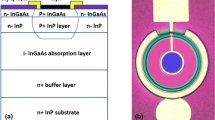Abstract
In this work, we examined the damage area and maximum surface temperature of silicon-based photodiodes (PIN) with varying external bias voltages under continuous laser irradiation at 1064 nm. The temperature at the silicon-based PIN detector's top surface center point is observed to steadily drop as the external bias voltage rises, and the extent of damage is also decreasing as the external bias voltage rises. Using COMSOL Multiphysics, a finite element simulation program, we ran a 2D numerical simulation of this process in order to better understand the mechanism underlying this phenomena. This is due to the fact that the produced thermons at 0 V bias voltage are mostly dependent on the detector surface, and when the bias voltage increases, the carrier's velocity of motion is accelerated and its heat accumulation is decreased, which lowers the detector temperature.








Similar content being viewed by others
Availability of data and materials
The data that support the findings of this study are available from the corresponding author upon reasonable request.
References
R. Enne, B. Steindl, H. Zimmermann, Speed optimized linear-mode high-voltage CMOS avalanche photodiodes with high responsivity. Opt. Lett. 40(19), 4400–4403 (2015)
W. Gaberl, B. Steindl, K. Schneider-Hornstein, R. Enne, H. Zimmermann, 035 μm CMOS avalanche photodiode with high responsivity and responsivity–bandwidth product. Opt. Lett. 39(3), 586–589 (2014)
Wang C., Xu YH., Li C., Lin HJ. Acta. Phys. Sin. 66 328–33 (2017)
Cox CE., Hennig W., Huber AC., Warburton WK., Grudberg PM., Asztalos SJ., Tan H., Biegalski S. IEEE Nuclear Science Symp and Medical Imaging Conf. (2013 NSS/MIC). 1–7 (2013)
Shi L., Sarubbi F., Nihtianov SN., Nanver LK., Scholtes TLM., Scholze F. 35th Annual Conf. of the IEEE Industrial Electronics. 1877–82 (2009)
G. Porrovecchio, M. Smíd, M. López, H. Hofer, B. Rodiek, S. Kück, Comparison at the sub-100 fW optical power level of calibrating a single-photon detector using a high-sensitive, low-noise silicon photodiode and the double attenuator technique. Metrologia 53, 1115–1122 (2016)
J.P. Moeglin, B. Gautier, R. Joeckle, D. Bolmont, SPIE 3287, 60–66 (1998)
S.E. Watlins, C.Z. Zhan, R.M. Walser, Electrical performance of laser damaged silicon photodiodes. Appl. Opt. 29, 827 (1990)
F. Bartoli, L. Esterowitz, R. Allen et al., Electrical performance of laser damaged silicon photodiodes. J. Appl. Phys. 47(7), 2875–2881 (1976)
M. Kruer, L. Esterowitz, R. Allen et al., Electrical performance of laser damaged silicon photodiodes. Infrared Phys. 16(3), 375–384 (1976)
F. Bartoli, L. Esterowitz, M. Kruer et al., Irreversible laser damage in ir detector materials. Appl. Opt. 16(11), 2934–2937 (1977)
M. Kruer, R. Allen, L. Esterowitz et al., Laser damage in silicon photodiodes. Opt. Quant. Electron. 8(5), 453–458 (1976)
D. Wang, Z. Wei, G. Jin, L. Chen, H. Liu, Experimental and theoretical investigation of millisecond-pulse laser ablation biased Si avalanche photodiodes. Int. J. Heat Mass Transfer. 122, 391–394 (2018)
Z.W. Li, X. Wang, Z.H. Shen, J. Lu, X.W. Ni, Numerical simulation of millisecond laser-induced damage in silicon-based positive-intrinsic-negative photodiode. Appl. Opt. 51, 2759–2766 (2012)
K. Wang, X. Yu, P. Li, T. Wang, Y. Zhang, C. Li, Nanomaterials for combinational radio-immuno oncotherapy. Laser Phys. (2020). https://doi.org/10.1002/adfm.201910676
Acknowledgements
This work is supported financially by the Science and Technology Development Program of Jilin Province (YDZJ202201ZYTS296) .
Author information
Authors and Affiliations
Contributions
Z.W. conceptualized, investigated, project managed and wrote the text of the manuscript for this article, J.Y. primarily performed data analysis, experiments, software use, plotting and review of the manuscript, L.G. performed experimental validation and software use, M.Z. and P.N. assisted with experiments and review of the manuscript, and all authors reviewed the manuscript.
Corresponding author
Ethics declarations
Competing interests
The authors declare no competing interests.
Additional information
Publisher's Note
Springer Nature remains neutral with regard to jurisdictional claims in published maps and institutional affiliations.
Rights and permissions
Springer Nature or its licensor (e.g. a society or other partner) holds exclusive rights to this article under a publishing agreement with the author(s) or other rightsholder(s); author self-archiving of the accepted manuscript version of this article is solely governed by the terms of such publishing agreement and applicable law.
About this article
Cite this article
Wei, Z., Yu, J., Gao, L. et al. Study of thermal effects in silicon-based PIN detectors with different external bias voltages irradiated by 1064 nm continuous laser. Appl. Phys. B 130, 58 (2024). https://doi.org/10.1007/s00340-024-08201-4
Received:
Accepted:
Published:
DOI: https://doi.org/10.1007/s00340-024-08201-4




